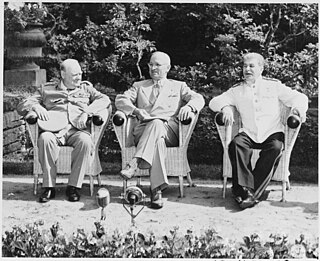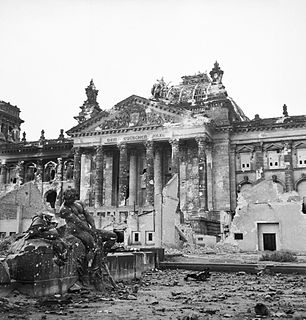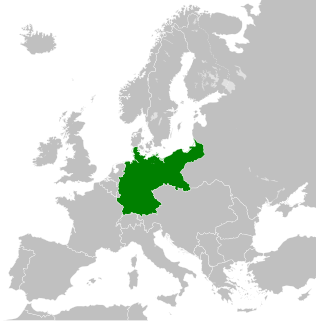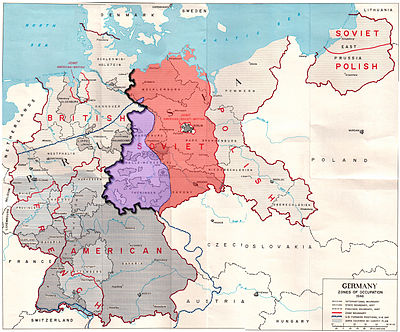
The Potsdam Conference was held at Cecilienhof, the home of Crown Prince Wilhelm in Potsdam, Germany, from 17 July to 2 August 1945. The participants were the Soviet Union, the United Kingdom, and the United States, represented respectively by Communist Party General Secretary Joseph Stalin, Prime Ministers Winston Churchill and Clement Attlee, and President Harry S. Truman.

The Potsdam Agreement was the August 1945 agreement between three of the Allies of World War II, the United Kingdom, the United States, and the Soviet Union. It concerned the military occupation and reconstruction of Germany, its borders, and the entire European Theatre of War territory. It also addressed Germany's demilitarisation, reparations and the prosecution of war criminals.

The Yalta Conference, also known as the Crimea Conference and code-named the Argonaut Conference, held February 4–11, 1945, was the World War II meeting of the heads of government of the United States, the United Kingdom, and the Soviet Union to discuss the postwar reorganization of Germany and Europe. The three states were represented by President Franklin D. Roosevelt, Prime Minister Winston Churchill, and Premier Joseph Stalin, respectively. The conference was held near Yalta in Crimea, Soviet Union, within the Livadia, Yusupov, and Vorontsov Palaces.

Schwerin is the capital and second-largest city of the northeastern German state of Mecklenburg-Vorpommern. It has a population of about 100,000.

Ludwigslust is a central castle town of Mecklenburg-Vorpommern, Germany, 40 km south of Schwerin. Since 2011 it is part of the Ludwigslust-Parchim district.
Following the termination of hostilities in World War II, the Allies were in control of the defeated Axis countries. Anticipating the defeat of Germany and Japan, they had already set up the European Advisory Commission and a proposed Far Eastern Advisory Commission to make recommendations for the post war period. Accordingly, they managed their control of the defeated countries through Allied Commissions, often referred to as Allied Control Commissions (ACC), consisting of representatives of the major Allies.

The Soviet Occupation Zone was the area of Germany occupied by the Soviet Union at the end of World War II in 1945. On 7 October 1949 the German Democratic Republic (GDR), commonly referred to in English as East Germany, was established in the Soviet Occupation Zone.

Torgau is a town on the banks of the Elbe in northwestern Saxony, Germany. It is the capital of the district Nordsachsen.

The German Instrument of Surrender was the legal document which effected the extinction of Nazi Germany and ended World War II in Europe. The definitive text was signed in Karlshorst, Berlin, on the night of 8 May 1945 by representatives of the three armed services of the Oberkommando der Wehrmacht (OKW) and the Allied Expeditionary Force together with the Supreme High Command of the Soviet Red Army, with further French and US representatives signing as witnesses. The signing took place 9 May 1945 at 00:16 local time.

The Race to Berlin was a competition between two Soviet marshals, Georgy Zhukov and Ivan Konev, to be the first to enter Berlin during the final months of World War II.

Elbe Day, April 25, 1945, is the day Soviet and American troops met at the Elbe River, near Torgau in Germany, marking an important step toward the end of World War II in Europe. This contact between the Soviets, advancing from the East, and the Americans, advancing from the West, meant that the two powers had effectively cut Germany in two.

Upon defeat of Nazi Germany in World War II, the victorious Allies asserted joint authority and sovereignty over 'Germany as a whole', defined as all territories of the former German Reich west of the Oder–Neisse line, having declared the destruction of Nazi Germany at the death of Adolf Hitler. The four powers divided 'Germany as a whole' into four occupation zones for administrative purposes, under the United States, United Kingdom, France and the Soviet Union respectively; creating what became collectively known as Allied-occupied Germany. This division was ratified at the Potsdam Conference. The four zones were as agreed in February 1945 by the United States, United Kingdom and Soviet Union meeting at the Yalta Conference; setting aside an earlier division into three zones proposed by the London Protocol.

Bresegard bei Picher is a small municipality in the German state of Mecklenburg-Vorpommern. Often it is simply referred to simply as Bresegard. There is another municipality within Mecklenburg also called Bresegard and to differentiate the two 'bei Picher' is added, signifying a close proximity to the town of Picher. The other Bresegard is near the town of Eldena and is called Bresegard bei Eldena. Bresegard bei Picher, part of the Amt of Hagenow-Land and the district (Landkreis) of Ludwigslust, is near the main highway between Berlin and Hamburg.

Picher is a municipality in the district of Ludwigslust-Parchim in the state of Mecklenburg-Vorpommern, Germany. Picher's population is 748.

The territorial changes of Germany include all changes in the borders and territory of Germany from its formation in 1871 to the present. Modern Germany was formed in 1871 when Otto von Bismarck unified most of the German states, with the notable exception of Austria, into the German Empire. After the First World War, Germany lost about 10% of its territory to its neighbours and the Weimar Republic was formed. This republic included territories to the east of today's German borders.

The Allied occupation of Austria started on 27 April 1945 as a result of the Vienna Offensive and ended with the Austrian State Treaty on 27 July 1955.

During World War II, the Soviet Union occupied and annexed several countries effectively handed over by Nazi Germany in the secret Molotov–Ribbentrop Pact of 1939. These included the eastern regions of Poland, as well as Latvia, Estonia, Lithuania, part of eastern Finland and eastern Romania. Apart from the Molotov–Ribbentrop Pact and post-war division of Germany, the USSR also occupied and annexed Carpathian Ruthenia from Czechoslovakia in 1945.
Victims of Yalta or The Secret Betrayal is a 1977 book by Nikolai Tolstoy that chronicles the fate of Soviet citizens who had been under German control during World War II and at its end fallen into the hands of the Western Allies. According to the secret Moscow agreement from 1944 that was confirmed at the 1945 Yalta conference, all citizens of the Soviet Union were to be repatriated without choice—a death sentence for many by execution or extermination through labour.
Events in the year 1945 in Germany.

The 5th Guards Army was a Soviet Guards formation which fought in many critical actions during World War II under the command of General Aleksey Semenovich Zhadov. The 5th Guards Army was formed in spring 1943 from the 66th Army in recognition of that army's actions during the Battle of Stalingrad. The 5th Guards Army fought in the Battle of Kursk, Belgorod-Khar'kov Offensive Operation, Battle of the Dnieper, Uman–Botoșani Offensive, Lvov–Sandomierz Offensive, Vistula–Oder Offensive, Berlin Offensive, and the Prague Offensive. During the Berlin Offensive elements of the army linked up with American troops at Torgau on the Elbe. Postwar, the army was disbanded as part of the Central Group of Forces.





















